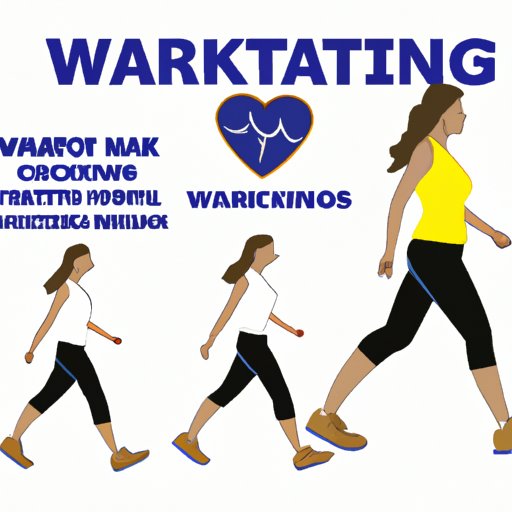Introduction
Cardio exercise is any type of physical activity that increases your heart rate for a sustained period of time. It is often used to improve overall cardiovascular fitness and can include activities such as running, swimming, cycling, and even walking. In this article, we will explore the health benefits associated with walking as a form of cardio exercise. We’ll look at how walking compares to other forms of cardio exercise, the different types of walking, and how to incorporate walking into your exercise routine.

Comparing Walking to Other Forms of Cardio Exercise
Walking is defined as a form of exercise in which one foot is placed in front of the other in a slow, steady rhythm while moving forward. It is considered a low-impact form of exercise and is often recommended for beginners who are just getting started with their fitness journeys. Walking is also a great way to stay active if you are recovering from an injury or have limited mobility.
When compared to other forms of cardio exercise, walking has some distinct advantages. It does not require any special equipment and can be done anywhere, anytime. It is also relatively low-impact, meaning that it is gentle on the joints and muscles. Additionally, walking can be done at a variety of paces, making it ideal for those who want to start slowly or increase the intensity of their workout over time.
The main disadvantage of walking is that it is not as effective at burning calories as other forms of cardio exercise. This means that it may take longer to achieve your desired results when using walking as your primary form of cardio exercise. Additionally, walking can become monotonous over time, so it is important to mix up your routine in order to stay motivated and make progress.
Exploring the Health Benefits of Walking
In addition to its cardiovascular benefits, walking provides numerous other health benefits. It can help to improve your physical fitness by strengthening your muscles and bones and increasing your endurance. It can also help you to maintain a healthy weight and reduce your risk of certain diseases, such as diabetes and heart disease.
Walking can also have a positive effect on your mental health. Studies have shown that regular walking can help to reduce stress, improve mood, and increase your energy levels. Additionally, walking outdoors can provide an opportunity to get away from the hustle and bustle of everyday life, giving you time to relax and clear your mind.

Examining Different Types of Walking and Their Effectiveness
There are several different types of walking that can be used to increase the intensity of your workout and maximize the health benefits. Power walking, also known as speed walking, involves taking longer strides and pumping your arms while walking in order to increase your speed and intensity. Interval walking involves alternating between periods of walking and jogging, allowing you to increase your speed and endurance over time. Finally, hill walking involves walking up and down inclines, which can help to build strength and endurance in your legs.

Investigating How to Incorporate Walking Into an Exercise Routine
If you are looking to add walking to your exercise routine, there are a few tips to keep in mind. Begin by setting realistic goals and tracking your progress. Start out slowly, gradually increasing your distance and intensity over time. Additionally, try to mix up your routine by walking in different places and exploring new trails. Finally, make sure to wear appropriate clothing and shoes for your walk, as well as sunscreen if you are walking outside.
Exploring the Science Behind How Walking is a Form of Cardio Exercise
The science behind how walking is a form of cardio exercise is fairly straightforward. When you walk, your body is forced to use more energy than it would at rest, which causes your heart rate to increase. This increased heart rate puts strain on your heart muscle, forcing it to work harder and become stronger. Additionally, walking can help to boost your metabolism, which can lead to improved weight management and better overall health.
Conclusion
Walking is a great form of cardio exercise that can provide numerous physical and mental health benefits. It is low-impact, easy to do, and can be done almost anywhere. Additionally, there are several different types of walking that can help to increase the intensity of your workout and maximize the health benefits. With the right approach and dedication, you can easily incorporate walking into your exercise routine and reap the rewards.


